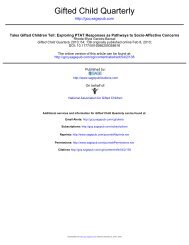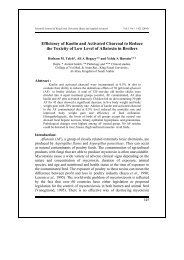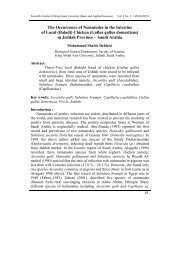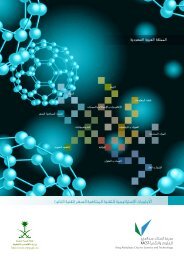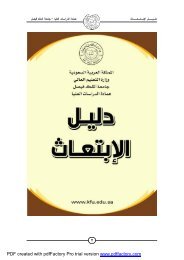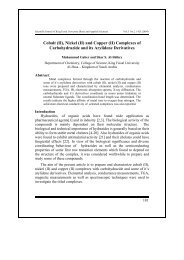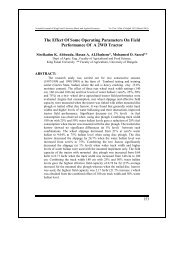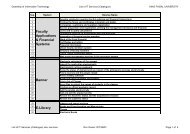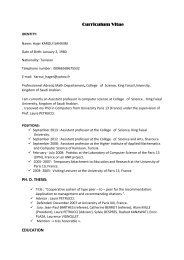ﺓﺩﺎﻤﻋ ﻲﻤﻠﻌﻟﺍ ﺚﺤﺒﻟﺍ
ﺓﺩﺎﻤﻋ ﻲﻤﻠﻌﻟﺍ ﺚﺤﺒﻟﺍ
ﺓﺩﺎﻤﻋ ﻲﻤﻠﻌﻟﺍ ﺚﺤﺒﻟﺍ
Create successful ePaper yourself
Turn your PDF publications into a flip-book with our unique Google optimized e-Paper software.
Kingdom of Saudi Arabia<br />
Ministry of Higher Education<br />
King Faisal University<br />
Deanship of Scientific Research<br />
% ٦٠ ﻥﻤ ﺭﺜﻜﺃ<br />
ﻲﺌﺎﻬﻨﻟﺍ<br />
% ٦٠ ﻭ<br />
ﻝﻮﳑ ﺚﲝ ﻉﻭﺮﺸﻣ ﺔﻌﺑﺎﺘﻣ ﺮﻳﺮﻘﺗ<br />
ﻊﺒﺍﺭﻟﺍ<br />
% ٣٠ ﻥﻴﺒ<br />
ـﻫ١٤٢٥/<br />
١٠/<br />
١٥<br />
: ﺦﻴﺭﺎﺘﻟﺍ<br />
١<br />
ﺙﻟﺎﺜﻟﺍ<br />
ﺔﻴﺑﺮﻌﻟا ﺔﻜﻠﻤﻤﻟا ﺔﻳدﻮﻌﺴﻟا<br />
ﻢﻴﻠﻌﺘﻟا ةرازو ﻲﻟﺎﻌﻟا<br />
ﻚﻠﻤﻟا ﺔﻌﻣﺎﺟ ﻞﺼﻴﻓ<br />
<strong>ﺓﺩﺎﻤﻋ</strong> <strong>ﻲﻤﻠﻌﻟﺍ</strong> <strong>ﺚﺤﺒﻟﺍ</strong><br />
ﻲﻨﺎﺜﻟﺍ<br />
لﻭﻷﺍ<br />
: ﺭﻴﺭﻘﺘﻟﺍ<br />
ﻩﺩﻴﻤﺤ ﻰﺴﻭﻤ ﺭﺩﺎﻘﻟﺍﺩﺒﻋ . ﺩ : ﺱﻴﺌﺭﻟﺍ ﺙﺤﺎﺒﻟﺍ . ١<br />
ﺔﻴﻨﺍﻭﻴﺤﻟﺍ ﺓﻭﺭﺜﻟﺍﻭ ﻱﺭﻁﻴﺒﻟﺍ ﺏﻁﻟﺍ : ﺔﻴﻠﻜﻟﺍ<br />
ﻥﻴﺯﺎﺒﺭﻗﻷﺍﻭ ﺔﻴﻭﻴﺤﻟﺍ ﺀﺎﻴﻤﻴﻜﻟﺍﻭ ﺀﺎﻀﻋﻷﺍ ﻑﺌﺎﻅﻭ : ﻡﺴﻘﻟﺍ<br />
-<br />
-<br />
: ﻉﻭﺭﺸﻤﻟﺍ ﻥﺍﻭﻨﻋ . ٢<br />
ﻕﻮﻨﻟﺍ ﺐﻴﻠﺣ ﰲ ﺎﻔﻠﺴﻟﺍ<br />
ﺔﻳﻭﺩﺃ ﺐﺤﺳ ﺓﺮﺘﻓ ﺪﻳﺪﲢ<br />
١٧,٠٠٠<br />
ﺓﺭﻴﻐﻟﺍ ﺙﻭﺤﺒﻟﺍ ٥١٠١ : ﻉﻭﺭﺸﻤﻟﺍ ﻡﻗﺭ . ٣<br />
ـﻫ١٤٢٥/<br />
٤/<br />
١<br />
ـﻫ١٤٢٥/<br />
١٠/<br />
١٥<br />
% ٣٠ﻭ<br />
% ١٠<br />
١٧,٠٠٠ : ﻉﻭﺭﺸﻤﻟﺍ<br />
: ﺭﻴﺭﻘﺘﻟﺍ<br />
ﺔﻴﻨﺍﺯﻴﻤ<br />
ﺦﻴﺭﺎﺘ ﻰﺘﺤ ﻑﺭﺼﻨﻤﻟﺍ<br />
: ﻉﻭﺭﺸﻤﻟﺍ ﻲﻓ ﺀﺩﺒﻟﺍ ﺦﻴﺭﺎﺘ<br />
: ﺀﺎﻬﺘﻨﻼﻟ ﻊﻗﻭﺘﻤﻟﺍ ﺦﻴﺭﺎﺘﻟﺍ<br />
-<br />
-<br />
-<br />
-<br />
: ﻉﻭﺭﺸﻤﻟﺍ ﻥﻤ ﺓﺯﺎﺠﻨﺍ ﻡﺘ ﺎﻤﻟ ﺔﻴﺒﻴﺭﻘﺘﻟﺍ ﺔﺒﺴﻨﻟﺍ . ٤<br />
ﻥﻴﺒ<br />
% ١٠<br />
ﻥﻤ لﻗﺍ<br />
: ﻉﻭﺭﺸﻤﻟﺍ ﻪﺠﺍﻭﺘ ﺕﺎﺒﻭﻌﺼ . ٥<br />
ﺩﺠﻭﺘ ﻻ -<br />
-<br />
ﻩﺩﻴﻤﺤ ﻰﺴﻭﻤ ﺭﺩﺎﻘﻟﺍﺩﺒﻋ . ﺩ : ﺭﻴﺭﻘﺘﻟﺍ ﺩﻌﻤ . ٦<br />
. ............................................... : ﻊﻴﻗﻭﺘﻟﺍ<br />
.<br />
............................................... : ﻲﻨﻭﺭﺘﻜﻟﻹﺍ<br />
ﺩﻴﺭﺒﻟﺍ
Title of Project :<br />
Final Report<br />
Establishment of Withdrawal Time of Sulfa Drugs in Camel Milk<br />
Investigator :<br />
Supported by :<br />
Project No : 5101<br />
Date : 21.10.1425<br />
Abdel Gadir Musa Homeida<br />
Deanship of Scientific Research , KFU<br />
٢
1. Literature Review<br />
Sulphonamidine (SDM) is one of the most extensively used drugs in veterinary<br />
medicine for prophlaxis and therapeutics . The metabolic pathway of the drug<br />
involves acetylation of the paraamino group (N4-acetylation), hydroxylation of<br />
heterocylic ring, glucuronidation (N1-position), sulphate conjugation and presumably<br />
other minor pathways (Gilman et al, 1991) . Marked species differences in the<br />
metabolism of SDM have been reported (Yuan and Fung, 1990) . Ruminants,<br />
monkeys, birds , pigs , primates, horses , camels and man are able to acetylate<br />
sulphonamide drugs (Vree and Hekster, 1985; Nouwas et al, 1983; Younan et al,<br />
1989) .<br />
Camel’s milk is less affected by storage and transportation than cow’s milk . It has<br />
been reported that the acidity increases slowly at 30 o C with little or no change in the<br />
taste (Knoess 1982) . The general practice in Saudi Arabia is to consume the milk<br />
fresh . However , most Bedouin families pool the surplus milk with goat’s milk and<br />
convert it to a dry fermented product called “Uqt” .<br />
Passage of Antimicrobial Agents into Milk :<br />
Studies of the penetration of antimicrobial agent’s from the systemic circulation<br />
into milk indicate that the mammary gland epithelium behaves as a lipoidal<br />
membrane which separates blood of pH 7.4 from milk . Which has a somewhat lower<br />
pH value ( normal pH range is 6.5 to 6.8 ) ( Baggot 1983 ) . The passage of each drug<br />
into milk is determined by the extent of binding to plasma albumin . the pK value and<br />
the degree of lipid solubility .<br />
It has been shown that only the hpid-soluble . nonionized moiety of an organic<br />
electroyte in the water phase of blood plasma diffuses into milk ( Rasmussen . 1966 ).<br />
The binding of sulfonamides to milk proteins varies from zero to 40 per cent<br />
٣
depending on the derivative. In normal lactating cows. Weak acids give milk<br />
ultrafiltrate-to-piasma ultrafiltrare concentration ratios less than or equal to 1:<br />
SDM residues have been found in milk following prophylactic and therapeutic use<br />
for mastitis, follwing intrauterine administration for treatment of metritis , or form<br />
contamination of milking equipment ( Pugh et al., 1977; Oliver et al., 1984; Egan and<br />
O Connor, 1983 ; Slee and Brightling . 1981 ; Egan and Meaney , 1985 ) .<br />
Risks to human health :<br />
Possible risk to man of SDM residues in milk includes :<br />
1. SDM – induced allergic reactions .<br />
2. Alteration of the gastro – intestinal flora .<br />
3. Prevalence of antmicrobial resistance among bacteria .<br />
4. Carriage by man of antimicrobial – resistant – bacteria of animal origin .<br />
Withdrawal Periods<br />
Probably the most controversial area associated with drugs use in farm animals is<br />
the adherence or otherwise to stated withdrawal periods . These are imposed in an<br />
endeavour to prevent any significant amount of drugs being present in meat , milk or<br />
animal products destined for human consumption .<br />
The term “withdrawal period” or “withdrawal time” is generally recognized as the<br />
period of time that must elapse between the last use of the drug preparation and the<br />
collection of meat or milk for human consumption ( Oliver et al 1990 ) . Generally<br />
speaking , adherence to withdrawal times presents a variety of problems for the<br />
stockman . These may range from the impracticability of changing over to non-<br />
٤
medicated feed shortly before disposal to the obvious difficulties presented by the<br />
random selection of animals from different pens for slaughter . Probably the only way<br />
to ensure a general adherence to withdrawal periods is to penalize those users who<br />
consistently fail to comply . In case of milk , certain countries introduce a blue dye<br />
with mastitis preparation so as to preclude blue-stained milk being forwarded for<br />
manufacture ; this would also provide a simple and rapid colorimetric screening test<br />
instead of a biological test for the presence of inhibitory substances . Unfortunately a<br />
problem with using such a dye is that no one substance would be excreted at the same<br />
rate as all the currently used antibiotics .<br />
b. Objectives<br />
1- The purpose of this study is to establish the withdrawal period of some<br />
common antibiotic preparations frequenthy used to freat dairy camel , in<br />
Saudi Arabia .<br />
2- To test whether SDM metabolites are excreted in milk .<br />
The antibacterial treatment of mastitis in lactating animals is of considerable<br />
regulatory concern because of the possibility of antibacterial residues in milk [1] .<br />
Although intramammary (i.m.m) infusion has been recognized as the route of choice<br />
for treating mastitis [2] , other investigators have recommended the use of combination<br />
of routes for administration of antibacterial agents [1,3] . Over 16% of milk samples<br />
collected 96h post-treatment were positive for antibiotic [3] .<br />
Sulphadimidine (SDM) is one of the most extensively used drugs in veterinary<br />
medicine for prophylaxis and therapeutics [4] . In camels, SDM is eleminated slowly<br />
from the body and the main SDM metabolite detected in plasma is N4-acetyl<br />
٥
derivative (N4-acetyl) [4, 5] . The withdrawal period for SDM and its metabolite is not<br />
prescribed in milk of lactating camel, therefore the objective of the present study<br />
were to deterime the concentration of SDM and its metabolite in milk after<br />
administration as a single or repeated-dose of treatments and follow the depletion of<br />
SDM in milk until its concentration dropped below the maximum residue limit.<br />
2. MATERIALS and METHODS<br />
Animals and treatments: Eight lactating one-humped camels, 4-5 years old,<br />
weighing 200-250 kg and representing various levels of milk production were used.<br />
Animals had free access to hay and water ad libitum. The camels were individually<br />
milked twice daily at 12h interval. Sulphadimidine (33.3%, Bremer Pharma GmbH,<br />
Germany) as a single dose treatment of 50 mg kg -1 (group1, 4 animals) or repeated<br />
dose treatments of 50 mg kg -1 (group2, 4 animals) was given intravenously (IV) to<br />
animals. The repeated doses were administered daily after morning milking for 3<br />
days.<br />
Collection of plasma and milk samples: Milk samples were collected at every<br />
milking from each cow. The first milk samples was taken before injection of drug.<br />
Samples were stored in labelled plastic containers at –20 o C until analysis. Blood<br />
samples were collected from group1 and 2 animals into heparinizied tubes,<br />
centrifuged at 2000 × g and plasma was separated and stored at –20 o C until analysis.<br />
٦
Sulphadimidine and its metabolite measurment: The HPLC analysis of SDM and<br />
N4-acetyl was previously described [5] . The mobile phase consisted of methanol,<br />
acetonitril, 0.02M Sodium acetate, 0.2M acetic acid and distilled water 15: 4: 27: 50:<br />
3.6, respectively. The detection limit for SDM and N4-acetyl<br />
Was 0.1 µg ml -1 .<br />
Protein binding: Ultrafilterate of selected plasma and milk samples were<br />
obtained with the reusable Micropartition System (Amicon Corp, Leyington, MA).<br />
The ultrafilterates obtained were measured by HPLC and percentage protein-binding<br />
was calculated as descriped previously [6] . Values were compared using Student's t-<br />
test [7] . The probability value P < 0.05 was considered significant<br />
3. RESULTS<br />
Sulphadimidine or its metabolite was not detected in any milk samples<br />
collected before dosing in single (group-1) and repeated dose (group-2) treatments.<br />
The mean concentration of SDM and N4-acetyl in milk was detected at the first<br />
milking (12h) post dosing in both groups (Table-1). Repeated injection of<br />
sulphadimidine in group-2 increased (P < 0.01) the concentration of both SDM and<br />
N4-acetyl in milk compared to group-1.<br />
Depletion of SDM and N4-acetyl to < 0.1 µg ml -1 occurred at 10 th (120h) and<br />
4 th (48h) milking, respectively, in single-dose treatment. Depletion of SDM and N4-<br />
٧
acetyl to < 0.1 µg ml -1 occurred at 16 th (192h) and 11 th (121h) milking, respectively,<br />
in repeated-dose treatment. SDM concentration were < 0.1 µg ml -1 at 120h after the<br />
last dose of treatment in both group.<br />
Sulphadimidine and N4-acetyl plasma protein binding was significantly (P <<br />
0.01) in single dose treatment (Table-2) highers than in repeated dosetreatment. The<br />
binding of SDM and N4-acetyl in milk protein was significantly (P < 0.01) lower<br />
than in plasma proteins, the ratio being < 1.<br />
٨
Table-1: Mean ±SD concentration (µg ml -1 ) of Sulphadimidine and N4-acetyl in<br />
milk of camels after intravenous administration of SDM as a single or<br />
repeated dose treatments at a dose of 50 mg kg -1 body weight. (n=4<br />
each).<br />
Milking No. Single-dose treatment Repeated-dose treatment<br />
SDM N4-acetyl SDM N4-acetyl<br />
Before dosing ND ND ND ND<br />
1 10.1 ± 2.1 0.3 ± 0.1 10.3 ± 2.0 0.41 ± 0.2<br />
2 5.3 ± 1.1 0.2 ± 0.1 14.2 ± 2.0 0.71 ± 0.3<br />
3 3.1 ± 0.6 0.1 ± 0.1 18.1 ± 2.5 0.73 ± 0.3<br />
4 2.1 ± 0.5 ND 16.1 ± 2.2 0.68 ± 0.4<br />
5 1.6 ± 0.4 ND 17.2 ± 2.5 0.70 ± 0.2<br />
6 1.2 ± 0.4 ND 16.0 ± 2.5 0.69 ± 0.3<br />
7 0.4 ± 0.2 12.3 ± 2.0 0.43 ± 0.2<br />
8 0.26 ± 0.1 10.1 ± 2.1 0.39 ± 0.2<br />
9 0.1 ± 0.1 6.2 ± 1.1 0.31 ± 0.1<br />
10 ND 3.1 ± 0.6 0.23 ± 0.1<br />
11 ND 2.3 ± 0.8 ND<br />
12 ND 1.6 ± 0.4 ND<br />
13 1.1 ± 0.4 ND<br />
14 0.4 ± 0.1<br />
15 0.21 ± 0.1<br />
16 ND<br />
17 ND<br />
18 ND<br />
ND: not detected or below assay sensitivity.<br />
٩
Table-2: Percentage binding of Sulphadimidine and N4-acetyl to plasma and milk<br />
proteins. (n=4 each).<br />
Samples Single-dose treatment Repeated-dose treatment<br />
SDM % N4-acetyl % SDM % N4-acetyl %<br />
Plasma 85 ± 3.1 83.1 ± 3.3 51.3 ± 2.1 46.4 ± 2.1<br />
Milk 41.1 ± 1.6 16 ± 1.8 44.2 ± 2.0 19.9 ± 1.7<br />
١٠
5. DISCUSSION<br />
Intravenous single-dose treatment or repeated-dose treatments with<br />
sulphadimidine produced increased concentration of SDM and its metabolite N4-<br />
acetyl in the milk of camel. Injection of sulphadimidine to cattle and sheep by<br />
different routes have also produced SDM in milk [8] . Since the sodium salts of SDM is<br />
basic in nature they tend to distribute more readily into milk due to pH aximum ng<br />
phenomenon [9] . The pH of milk is acidic (6.6), therefore, SDM will ionize and be<br />
excreted in milk.<br />
Residues of SDM in milk must be controlled as recent evidence indicating that<br />
SDM may be carcinogenic in human consuming small amounts over long period of<br />
time [10] . The primary reason for the occurrence of SDM residues in milk were the<br />
failure to observe drug withdraural time when drug concentration is at aximum<br />
residue limit (MRL). The MRL in milk was suggested to be 0.1 µg ml -1[11] . Depletion<br />
of SDM to MRL of 0.1 µg ml -1 in this study occurred five days post injection in<br />
single-dose treatment or five days after the last injection in repeated-dose treatment<br />
suggesting that five days could be considered as Withdrawal period in milk of<br />
camels. For dairy cows a period of 3-4 days was suggested as Withdrawal period in<br />
milk [8] .<br />
١١
In repeated-dose treatments the percentage protein binding for SDM and N4-<br />
acetyl was relatively less than in single-dose treatment. Similar observations at high<br />
and low plasma concentration of SDM have been reported [12] . A saturation of protein<br />
binding sites has to be assumed, and SDM may compete with its metabolite for the<br />
same binding site [8] . The fact that metabolite concentrations in milk did not exceed<br />
those of parent drug and milk protein binding for metabolite was very low, suggests<br />
that monitoring of sulphadimidine in milk of camel could be limited to SDM alone.<br />
ACKNOWLEDGEMENTS<br />
The authors thanks the Deanship of Scientific Research, King Faisal University<br />
for financial support.<br />
١٢
5. REFERENCES<br />
[1] Sandholm M., Kaartinen, L. and Pyorala S. (1990). Bovine mastitis-why<br />
does antibiotic therapy not always work? An overview. J. Vet. Pharmacol.<br />
Therap., 13: 248-260.<br />
[2] Soback S. (1988).Therapeutic success or failure in mastitis therapypharmacologic<br />
approach. J. Vet. Med., 44: 233-243.<br />
[3] Seymour E. M., Jones G. M. and Gilliard M. L. (1988). Persistence of<br />
residues in milk following antibiotic treatment of dairy cattle. J. Dairy Sci., 71:<br />
2292-2296.<br />
[4] Younan W., Nouws J. F. M., Homeida A. M., Vree T. B. and Degen M.<br />
(1989). Pharmacokinetics and metabolism of sulphadimidine in the camel. J.<br />
Vet. Pharmacol. Therap., 12: 327-329.<br />
[5] Homeida A. M. (2000). Phenotypic variation in sulphoramide acetylation. J.<br />
Camel Pract. Res., 7: 109-111.<br />
[6] Al-Nazawi M. H. (2005). Pharmacokinetics and tolerance of thiamphenicol in<br />
camels and sheep. Intl. J. Pharmacol.,. 1: 25-28.<br />
[7] Kirkwood, B. R. (1988). Essential of Medical Statistics. Blackwell<br />
Scientific Publications, Oxford.<br />
[8] Nouws J. F. M., Vree T. B., Breukink H. J., Baakman M., Driessens F. and<br />
Smulders A. (1985).Dose dependent Disposition of sulphadimidine and its N4acetyl<br />
and hydroxy metabolites in plasma and milk of dairy cows. The Vet.<br />
١٣
Quart., 7: 177-186.<br />
[9] Riviere J. E. and Sundlof S. F. (2001). Chemical residues in tissues of food<br />
animals. In: Veterinary Pharmacology and Therapeutics. H. R. Adams (Ed.),<br />
Iowa State University Press, Iowa, pp. 1167-1174.<br />
[10] Littlefield N. A., Sheldon W. G., Allen R. and Gaylor D. W. (1990).<br />
Chronic toxicity/carcinogenicity studies of sulphamethazine in Fischer 334/N<br />
rats. Food Chem. Toxicol., 28: 157-167.<br />
[11] Bevill R. F. (1989). Sulfonamide residues in domestic animals. J. Vet.<br />
Pharmacol. Therap., 12: 241-252.<br />
[12] Vree T. B. and Hekster Y. A. (1985). Pharmacokinetics of sulphonamides<br />
revisited. Antibiotics and Chemotherapy, 34: 201-208.<br />
١٤



